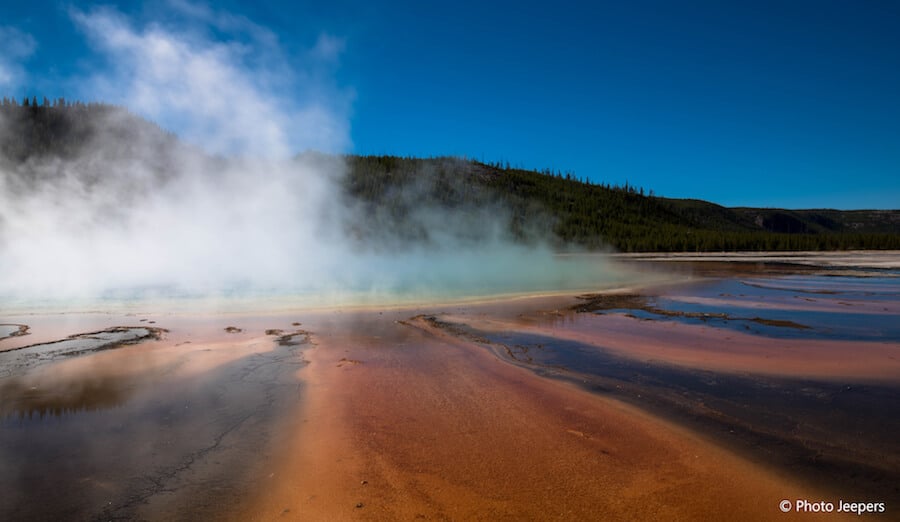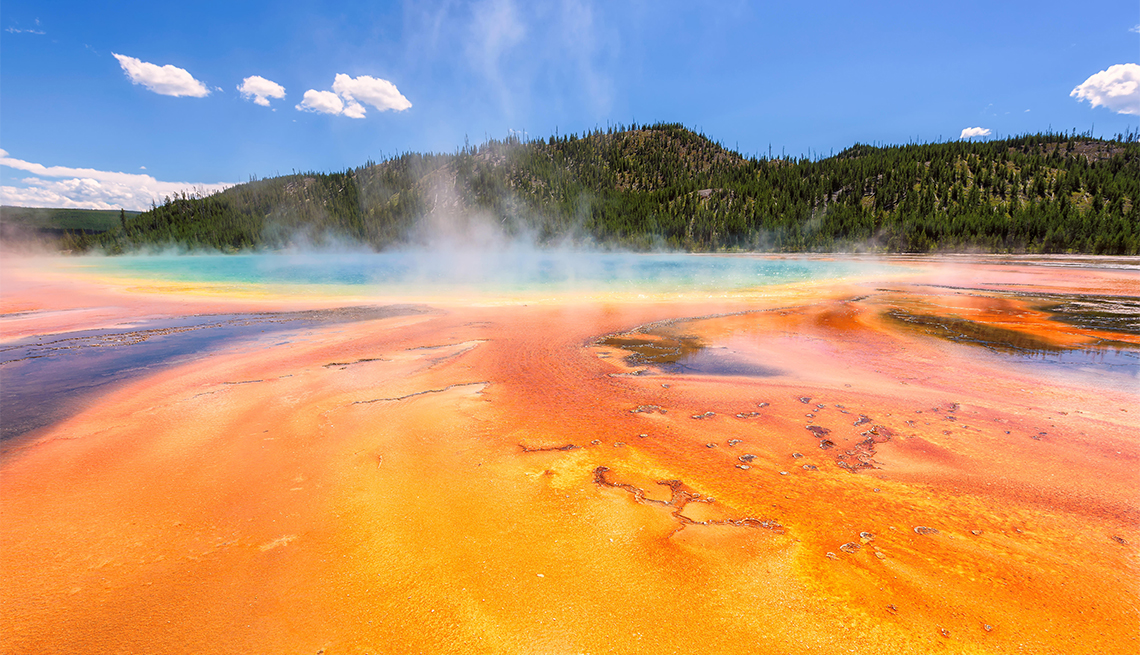Assuming you would like tips on how to plan a trip to see the Grand Prismatic Spring:
1. Check the weather in advance and plan your trip around the most ideal conditions – you don’t want to be caught in a downpour or blizzard!
2. Give yourself plenty of time to get there – the drive from Yellowstone’s south gate is about an hour.
3. Once you arrive at the Midway Geyser Basin, follow the boardwalk towards the right and keep an eye out for other geothermal features along the way. The walk to Grand Prismatic Spring is about 0.8 miles round-trip.
4. Be sure to stay on the boardwalk at all times – getting too close to any of these hot springs can be dangerous (and deadly).
5. And finally, don’t forget your camera! The vibrant colors of Grand Prismatic make it one of Yellowstone’s most photographed landmarks.
Table of Contents
- 1 Grand Prismatic Spring Yellowstone | HOW TO GET TO THE GRAND PRISMATIC OVERLOOK
- 2 How to Get to Grand Prismatic Spring
- 3 Grand Prismatic Spring Death
- 4 How Deep is the Grand Prismatic Spring
- 5 How Hot is the Grand Prismatic Spring
- 6 Why is the Grand Prismatic Spring So Dangerous
- 7 Grand Prismatic Spring Colors
- 8 Why is the Grand Prismatic Spring So Colorful
- 9 How Long Does It Take to Visit Grand Prismatic Spring?
- 10 What Time of Day is Best to See Grand Prismatic Spring?
- 11 How Do You Get to Grand Prismatic Spring?
- 12 How Long is the Hike to Grand Prismatic Spring Overlook?
- 13 Conclusion
Grand Prismatic Spring Yellowstone | HOW TO GET TO THE GRAND PRISMATIC OVERLOOK
- Step 1: Choose your dates
- When are you planning on going? Step 2: Decide how you want to get there
- Are you driving, flying, or taking a bus? Step 3: Once you know how you’re getting there, book your transportation and accommodations
- Make sure to give yourself enough time to get there and back! Step 4: Start packing your bags! What will you need for the trip? Clothes, toiletries, snacks, etc
- ? Step 5: Don’t forget to bring your camera! You’ll want to take lots of pictures of the beautiful spring
How to Get to Grand Prismatic Spring
Grand Prismatic Spring is one of the most iconic geothermal features in Yellowstone National Park. The spring is located in the Midway Geyser Basin, and is easily accessible from a boardwalk that circles the basin.
The best time to visit Grand Prismatic Spring is during the summer months when the water temperature is warmer and the crowds are thinner.
However, even in winter the spring is an impressive sight, with steaming water surrounded by snow and ice.
To get to Grand Prismatic Spring, start at Madison Junction and take the Firehole Lake Drive south for about 3 miles. The spring will be on your left just before you reach Midway Geyser Basin.
There is a large parking area here, so you shouldn’t have any trouble finding a spot. From the parking lot, it’s an easy walk to the boardwalk that loops around the basin.
Grand Prismatic Spring Death
Grand Prismatic Spring is one of the most popular tourist destinations in Yellowstone National Park. However, the spring has been the site of several deaths over the years. In 2016, a 23-year-old man from Oregon died after falling into the spring.
In 2011, a 17-year-old girl from Montana died after she slipped and fell into the spring while hiking with her family. And in 2000, a 7-year-old boy from Idaho died after he wandered off the boardwalk and fell into the spring.
How Deep is the Grand Prismatic Spring
If you were to ask someone how deep the Grand Prismatic Spring is, they might not know the answer. After all, it’s not something that is easily measured. However, according to recent studies, the average depth of the Grand Prismatic Spring is about 160 feet.
The Grand Prismatic Spring is located in Yellowstone National Park and is known for its vibrant colors. The colors are created by bacteria that thrive in hot water. The spring gets its heat from geothermal activity below the earth’s surface.
The spring was first discovered in 1871 by members of the Hayden Geological Survey. At that time, it was thought to be the world’s largest hot spring. Today, we know that there are many springs around the world that are larger than the Grand Prismatic Spring.
Despite its smaller size, the Grand Prismatic Spring is still an amazing sight to see. If you ever have a chance to visit Yellowstone National Park, make sure to take a look at this beautiful natural wonder!
How Hot is the Grand Prismatic Spring
The Grand Prismatic Spring in Yellowstone National Park is one of the most popular attractions in the park. The spring is known for its vivid colors, which are created by bacteria that thrive in the hot water. The spring gets its heat from a magma chamber beneath Yellowstone.
The water in the spring can reach temperatures of up to 93 degrees Celsius (199 degrees Fahrenheit).
Why is the Grand Prismatic Spring So Dangerous
The Grand Prismatic Spring is one of the most popular tourist attractions in Yellowstone National Park. But what many people don’t realize is that it is also one of the most dangerous places in the park.
The spring gets its name from its vibrant colors, which are created by bacteria that thrive in the hot water.
The water in the spring can reach temperatures of up to 122 degrees Fahrenheit, and it is this extreme heat that makes the spring so dangerous.
There have been several fatalities over the years, and dozens of people have been seriously injured. So why do people keep coming back to this dangerous place? The answer is simple: because it’s absolutely stunning.
The colors are unlike anything else on Earth, and it’s a truly unique experience to see in person. Just be sure to stay safe and never venture too close to the edge!
Grand Prismatic Spring Colors
The Grand Prismatic Spring in Yellowstone National Park is one of the most beautiful and popular attractions in the park. The spring gets its vibrant colors from the different bacteria that live in it. The bacteria produce pigments that absorb light, which makes them appear red, orange, or yellow.
These pigments also help the bacteria to survive in hot environments.
Why is the Grand Prismatic Spring So Colorful
The Grand Prismatic Spring is one of the most iconic and beloved features of Yellowstone National Park. Its vibrant colors are a source of wonder for visitors from all over the world. But why is this natural phenomenon so colorful?
The answer lies in the microbes that live in the spring. These tiny organisms are responsible for producing the carotenoids that give the water its vivid hues. The different types of microbes thrive at different temperatures, which is why you can see distinct bands of color in the spring.
The blue-green hues near the center of the spring are produced by thermophilic bacteria, which can withstand higher temperatures than other microbial life. These bacteria get their energy from chemical reactions that occur at high temperatures. As you move away from the center of the spring, the water becomes cooler and different species of bacteria take over.
These include orange-hued bacteria that produce beta-carotene, yellow bacteria that produce xanthophylls, and red bacteria that produce lycopene.
It’s these carotenoids that give rise to the stunning colors of Grand Prismatic Spring—and they’re what make it such a uniquely beautiful place on Earth.

Credit: maketimetoseetheworld.com
How Long Does It Take to Visit Grand Prismatic Spring?
Grand Prismatic Spring is one of the most iconic and popular geothermal features in Yellowstone National Park. While its size is impressive, at 370 feet in diameter, it is the vivid colors that make this spring truly unique. The brilliant blue center is surrounded by a ring of yellow, then orange, and finally red.
These colors are created by different types of bacteria that thrive in these hot springs.
So how long does it take to visit Grand Prismatic Spring? That really depends on what you want to do.
If you just want to see the spring from the boardwalk, it will only take a few minutes. But if you want to hike around the Grand Loop Road and get different views of the spring (including from above), it could take a couple of hours or more.
No matter how long you spend at Grand Prismatic Spring, it is sure to be an unforgettable experience!
What Time of Day is Best to See Grand Prismatic Spring?
The best time of day to see Grand Prismatic Spring is early in the morning when the sun is rising. The colors of the spring are most vibrant when they are illuminated by the sun.
How Do You Get to Grand Prismatic Spring?
Grand Prismatic Spring is one of the most popular attractions in Yellowstone National Park. The spring is located in the Midway Geyser Basin, and is easily accessible by boardwalk. To get to Grand Prismatic Spring, follow these steps:
1. Enter Yellowstone National Park from either the north or south entrance.
2. Head towards the Midway Geyser Basin, which is located between Old Faithful and West Thumb geyser basins. The basin can be reached by car, bike, or foot.
3. Once you arrive at the basin, follow the wooden boardwalk to Grand Prismatic Spring. The spring is about 0.5 miles from the parking area (one-way).
4. Enjoy the views!
Be sure to stay on the boardwalk at all times as there are scalding hot waters just below the surface of Grand Prismatic Spring.
How Long is the Hike to Grand Prismatic Spring Overlook?
Grand Prismatic Spring is one of the most popular attractions in Yellowstone National Park. The spring is located in the Midway Geyser Basin, and its vibrant colors are created by bacteria that thrive in the hot water. The hike to Grand Prismatic Spring Overlook is about 1.5 miles round trip, and it’s a relatively easy hike with only a few small hills.
The trailhead is located near the Fairy Falls Parking Area, and there are several signs along the way that provide information about the spring. The overlook offers spectacular views of Grand Prismatic Spring, and it’s a great place to take photos or just enjoy the view.
Conclusion
Planning a trip to Grand Prismatic Spring can be easy if you follow these steps. First, decide when you want to go and book your travel accordingly. Second, research the best time of day to visit the spring so you can enjoy its beauty to the fullest.
Third, pack your camera and binoculars so you can capture its natural wonder. Finally, relax and take in all that this amazing place has to offer!
